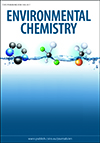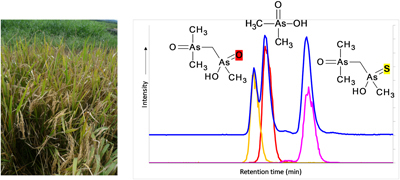Joerg Feldmann (University of Graz, Austria)
This Special Issue is a dedication to Professor Kevin Francesconi, father of organoarsenicals in the environment, and a previous Editor-in-Chief of this journal, Environmental Chemistry.

Volume 20 Numbers 1 & 2 2023
Special IssueDedication to Professor Kevin Francesconi
 , Patricia Grinberg
, Patricia Grinberg  , Kevin Kubachka, Mesay Wolle
, Kevin Kubachka, Mesay Wolle  , Andrea Raab
, Andrea Raab  , Joerg Feldmann
, Joerg Feldmann  , Rebecca Sim
, Rebecca Sim  , Ásta H. Pétursdóttir
, Ásta H. Pétursdóttir  , Tomáš Matoušek
, Tomáš Matoušek  , Stanislav Musil
, Stanislav Musil  , Ben Wozniak, Stephen Springer, Nausheen W. Sadiq, Hakan Gurleyuk, Calvin H. Palmer, Indumathi Pihillagawa Gedara and Zoltan Mester
, Ben Wozniak, Stephen Springer, Nausheen W. Sadiq, Hakan Gurleyuk, Calvin H. Palmer, Indumathi Pihillagawa Gedara and Zoltan Mester 
Environmental context. Arsenic can be found in all environmental compartments in a large number of chemical forms of varying toxicity. We performed an inter-laboratory comparison study focusing on quantitation of some of the most toxic arsenic forms in seven different biological materials and found very good agreement among the submitted results. Certification of the studied materials will provide suitable quality control samples for environmentally relevant concentrations of arsenic in food products and biota.
EN23006 Abstract | EN23006 Full Text | EN23006PDF (1 MB) | EN23006Supplementary Material (873 KB) Open Access Article
Environmental context. The marine ecosystem is highly elevated in arsenic in comparison to the terrestrial environment. More than 100 different naturally occurring organoarsenic compounds have been found in different marine organisms. In order to understand how highly toxic AsHCs are formed and bioaccumulate in different marine organisms, large scale monitoring of AsHCs from a range of different laboratories is necessary. Despite their toxicity, AsHCs have not been extensively studied due in part to the lack of low-cost analytical methods and the lack of commercially available standards.
Environmental context. Arsenic exists in different chemical forms in our environment, among others as arsenolipids that are predominately found in appreciable quantities in various marine organisms (seafood). Their origin, biosynthetic pathway, toxicity and their potential biological role are not fully understood. We report purification strategies for environmental and human health relevant arsenolipids to broaden and support innovative arsenolipid research.
 , Francisco L. F. da Silva
, Francisco L. F. da Silva  , Savarin Sinaviwat
, Savarin Sinaviwat  , Andrea Raab
, Andrea Raab  , Eva M. Krupp, Gisele S. Lopes
, Eva M. Krupp, Gisele S. Lopes  , Ana R. A. Nogueira
, Ana R. A. Nogueira  and Joerg Feldmann
and Joerg Feldmann 
Environmental context. Intensive aquaculture is the main source of fisheries products. Thus, investigating the food safety of these products and the environmental impacts of the farms on mangroves is necessary. A shrimp productive cycle was evaluated with a focus on trace element accumulation in shrimps and effluent. The results revealed secure levels of elements in the final product; however, the effluent produced in farms is an important source of contamination to mangrove environment.
Environmental context. Arsenic contamination has a disproportionate effect on marine ecosystems. Organisms such as some marine macroalgae, which accumulate potentially toxic elements from the surrounding environment, have developed an internal conversion process that is not yet fully understood. Are arsenic-containing sugars a product of detoxification, or simply the result of phospholipid degradation?
Environmental context. With mushroom consumption increasing worldwide, it is important to know about the concentration of different arsenic species in the most commonly eaten mushroom species, especially since the toxicity depends on the chemical structure. No dangerous amounts of the highly toxic inorganic arsenic were detected in the studied mushrooms. It is therefore safe to consume mushroom fruit-bodies of the investigated species, at least with regard to the arsenic content.

Environmental context. The arsenic content and its speciation in harvested rice are dependent on the genetics of the rice variety, the agricultural practise as well as the speciation of arsenic in the soil. The geochemical conditions and therefore the microbiological regime in the paddy fields can influence the biomethylation of the arsenic in the porewater and therefore can influence the extent of arsenic uptake and its speciation in rice plants.
Environmental context. Rice is a staple diet for many people worldwide. Rice accumulates arsenic naturally from soils and is thought to cause straighthead disease. This disease causes sterility in rice resulting in a lack of grain formation and hence the head of the rice remains upright at maturity.
Environmental context. Seaweed is a good natural dietary source of iodine, and some types of seaweed are rich in iodine. Iodine has a diverse chemistry in seaweeds and may exist as different chemical species; however, the occurrence and identity of the individual species are still not fully elucidated. Hence, development of sensitive and selective iodine speciation methods for studies of iodine chemistry and biotransformation in seaweeds are needed.